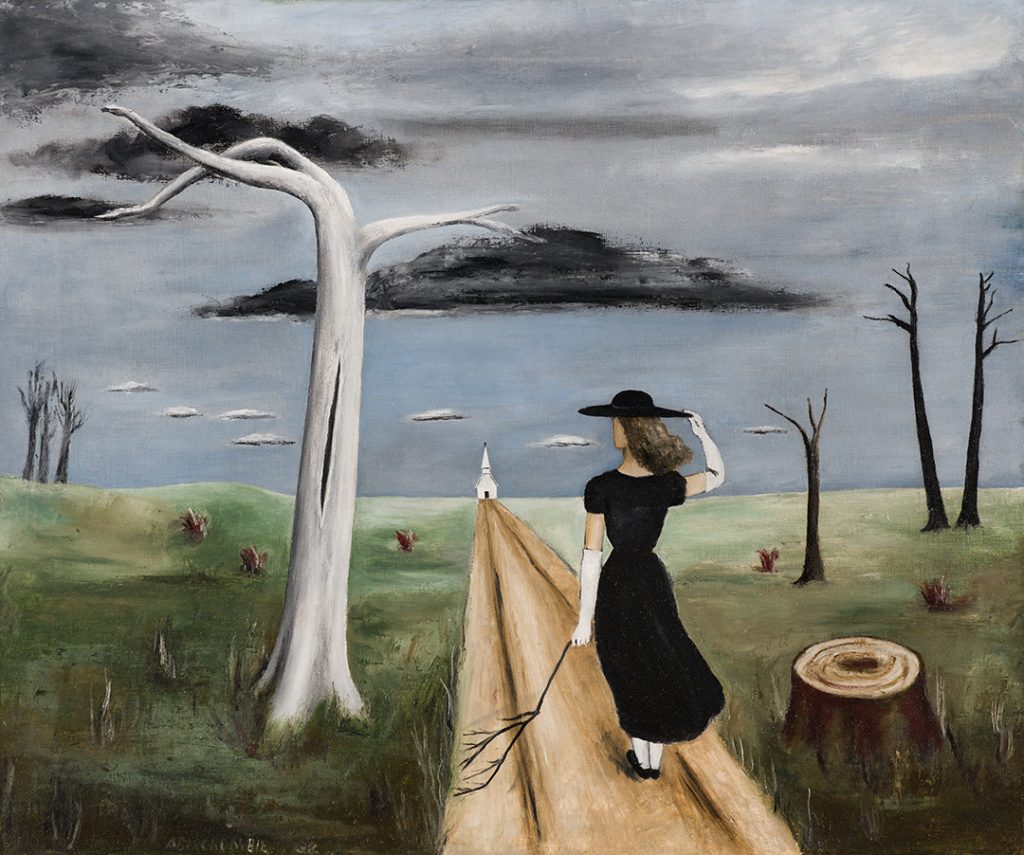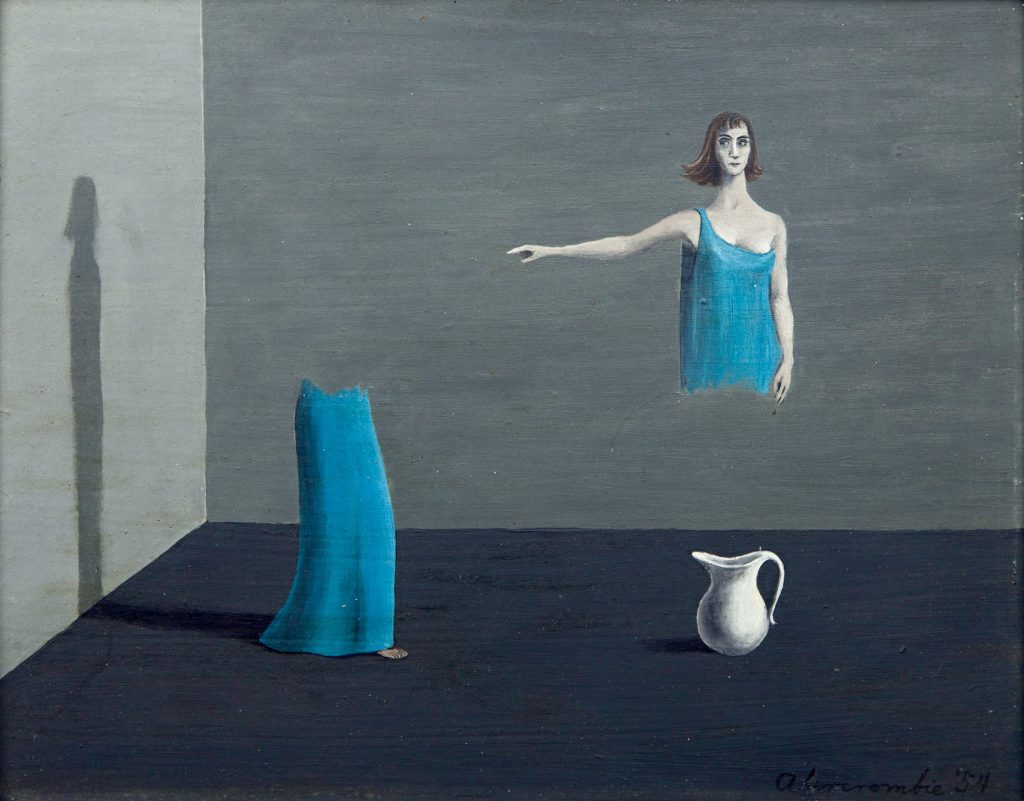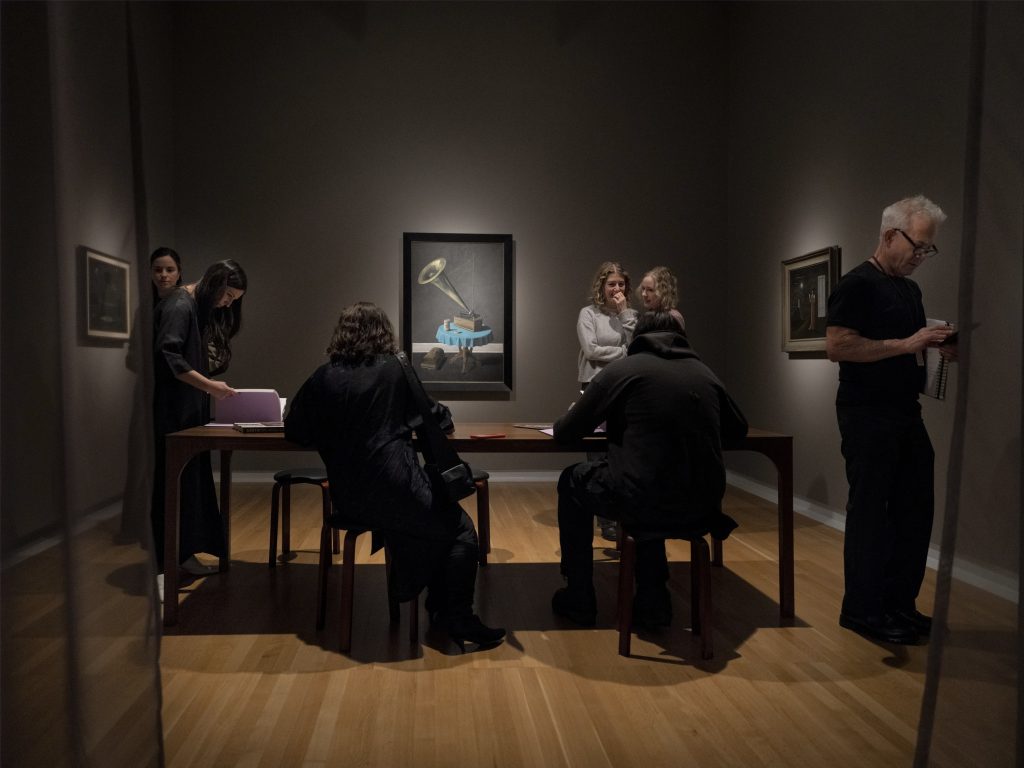Visions of Strange Worlds Within Ourselves: Gertrude Abercrombie’s Paintings at Carnegie Museum of Art

One of the best places to see visual art in Pittsburgh is an unusual exhibition space with an eerie ambiance. Located within Carnegie Museum of Art, the museum’s Scaife Gallery 1 is a narrow, shadowy corridor about 50 yards long, running next to rooms that hold the permanent collection. The corridor is walled off from those airier spaces except for an open portal near each end. Inside the corridor, the only illumination comes from small, ceiling-mounted spotlights, each focused tightly on an individual artwork, so that rows of paintings glow like torches in twilight. Step through the entry portal and you feel as if you’re plunging into a hidden dimension: a secret tunnel of art.
Gallery 1 now provides the perfect setting for a show of paintings that tunnel deep into hidden dimensions of the human psyche. The exhibition, titled Gertrude Abercrombie: The Whole World Is a Mystery, runs through June 1. Calling it a must-see would be much too trite. It’s more like a must-feel. The pictures in this one-woman retrospective invite you to feel how it feels to move through life in a tangled, turbulent world while carrying a secret, solitary inner world within.
Scroll back up, if you need to, and spend some moments with Abercrombie’s painting “The Church” at the top of this review. Talk about a picture that’ll make you dizzy: Everything seems to be one thing and yet also another thing at the same time. In motion, and yet static. Alive, but maybe dead; the trees are busy searching but they’re barren. Crazy perspective, locked in solid, yet atilt. What is that expanse looming beyond the horizon line—a sky with clouds, a sea with shadowy islands, or both? No wonder the witchy woman has to hold onto her hat.
And speaking of dizzy, the jazz trumpeter Dizzy Gillespie was one of Abercrombie’s close friends. He called her the ultimate “bop artist.” Others dubbed her the bohemian queen of Chicago’s South Side. She was a popular party girl—turn her loose at a piano and she could improvise like a champ—but also a woman prone to spells of dark depression. The paintings you’ll see in the show are predominantly on the dark and sinister side. Yet there’s a sneaky playfulness about them that sends you away feeling strangely enlivened. The whole world is a mystery, indeed.

An Artist’s Life
Gertrude Abercrombie (1909 – 1977) carved a singular path through the fertile artistic times of the middle 20th century. Raised in a musical family by parents who were opera singers, she gradually branched out, earning a liberal arts degree at the University of Illinois and then settling in Chicago, where she took art classes and worked for a time as a commercial artist.
Life got hectic from there. Abercrombie immersed herself in Chicago’s fast-blooming jazz scene. Along with Gillespie, her friends included a veritable all-star lineup of musicians such as Charlie Parker, Marian McPartland, and Sonny Rollins. In addition to her various love affairs, Abercrombie married twice, with both unions ending in divorce, and had one child—a daughter, Dinah, born in 1942 and named after vocalist Dinah Washington, then a teenage phenom in the city’s jazz clubs.
And amid the hubbub, Abercrombie painted. Her peak period ran from the 1930s through the ‘50s, after which health problems slowed her down. Her work was fairly well known for a while but then slipped into obscurity for a much longer while, until a recent revival of interest. The exhibition at Carnegie Museum of Art—accompanied by a richly illustrated book about the artist and her work—now stands at the center of that revival.
A Trip Through Constellations
The show is a big one, 85 pieces in all. CMOA’s Cynthia Stucki, who served as curatorial assistant, said in a phone interview that there were multiple reasons for putting so much effort into the venture. First and foremost, Abercrombie’s art is “still under-recognized” in relation to its quality. Her work was also distinctive for its time in art history: “At the height of her career, in the 1950s, what was really popular in centers like New York was abstract expressionism,” Stucki noted. “But here was Gertrude Abercrombie, painting in a very different language”—and though we’d call her style surrealism, “she was not trying to be a European surrealist either.”
More than most artists ever do, Abercrombie literally put herself into her work. The show includes a few striking self-portraits. There are many paintings in which she’s a black-robed, witch-hatted figure wandering through weird landscapes, or lurking somewhere to behold a bizarre scene unfolding. And in case you’re wondering how such stuff relates to the bebop played by Gillespie et al, Stucki has an insight that nails it: The art is jazz-like in the sense that it features “lots of repetition, but in different constellations.”

Then too, many paintings don’t show the artist but are nonetheless personal in a spooky way, like a sinuous saxophone solo. Gaze upon a stark interior of a sparsely furnished room and you’ll notice a cat sitting in the corner, returning your gaze intently, as if to ask “What do you see here?” Nearby are surreal object paintings, in which mysterious objects—pyramids, ladders, moons—seem to speak in strange tongues of their own. And still lifes that aren’t so still after all.
An art-appreciation lecturer could spend hours rhapsodizing on the feelings evoked and the meanings suggested. I will simply urge you to visit the show and see for yourself. Along with Cynthia Stucki, I would further recommend that you go leisurely, not like a manic meaning-extractor, but allowing time to absorb the aura cast by the paintings. You will be contacted. Perhaps with important messages. Or at least with hints as to what they might be.
Closing Credits and Visitor Info
Gertrude Abercrombie: The Whole World Is a Mystery was co-organized and chief-curated by Eric Crosby, the Henry J. Heinz II Director of Carnegie Museum of Art, and Sarah Humphreville, the Lunder Curator of American Art at Colby College Museum of Art. The exhibition will travel to Colby (and later to Milwaukee Art Museum) after its run here. Currently it’s up through June 1 at 4400 Forbes Ave. in Pittsburgh’s Oakland district. For further information, see Carnegie Museum of Art’s webpage for the exhibition.

Mike Vargo, an independent writer based in Pittsburgh, reports on visual arts and theater for Entertainment Central.
Share on Social Media
Follow Entertainment Central
Latest Stories
Sign up for the EC Newsletter







